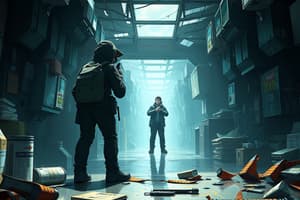Podcast
Questions and Answers
What does a positive fracture match indicate?
What does a positive fracture match indicate?
- The fractured materials were part of a single unit. (correct)
- The items were from different origins.
- The evidence cannot be conclusively tested.
- The items were never connected.
Which of the following is NOT a type of evidence typically examined for fracture matching?
Which of the following is NOT a type of evidence typically examined for fracture matching?
- Plastic
- Paint
- Wood (correct)
- Glass
What is the preferred method for packaging fragile fractured items?
What is the preferred method for packaging fragile fractured items?
- Wrap them in newspaper.
- Use a box cushioned with tissue. (correct)
- Place them in a cardboard box without cushioning.
- Seal them in a plastic bag without support.
What should you NOT do when dealing with fractured items in the field?
What should you NOT do when dealing with fractured items in the field?
When should an examiner contact to inquire about remaining examinations?
When should an examiner contact to inquire about remaining examinations?
What is a key reminder when submitting evidence for fracture matching?
What is a key reminder when submitting evidence for fracture matching?
Which item is suitable for conducting a fracture match examination?
Which item is suitable for conducting a fracture match examination?
Which item should be avoided for packaging fractured evidence?
Which item should be avoided for packaging fractured evidence?
Flashcards are hidden until you start studying
Study Notes
Trace Evidence: Fracture Match
- The Virginia Department of Forensic Science offers fracture match examinations.
- Fracture matches involve physically fitting items of evidence back together.
- A positive fracture match is conclusive evidence that the fractured materials were once part of a single unit.
- The Trace Evidence Section typically examines evidence such as plastic, vehicle parts, paint, tapes, glass, fabric, ropes, and cordage.
- The examination determines whether or not one or more items were once part of a single unit.
- The guidelines for collecting fractured items advise protecting them from further damage.
- Package broken items in plastic or paper bags or boxes and cushion them with tissue.
- Place particularly fragile items in a box cushioned with tissue.
- Do not attempt a fracture match in the field.
- If a fracture match attempt is successful, the examiner will contact the submitter to inquire about additional necessary examinations.
- A successful fracture match often eliminates the need for further testing.
- Protect evidence from further damage.
Studying That Suits You
Use AI to generate personalized quizzes and flashcards to suit your learning preferences.




